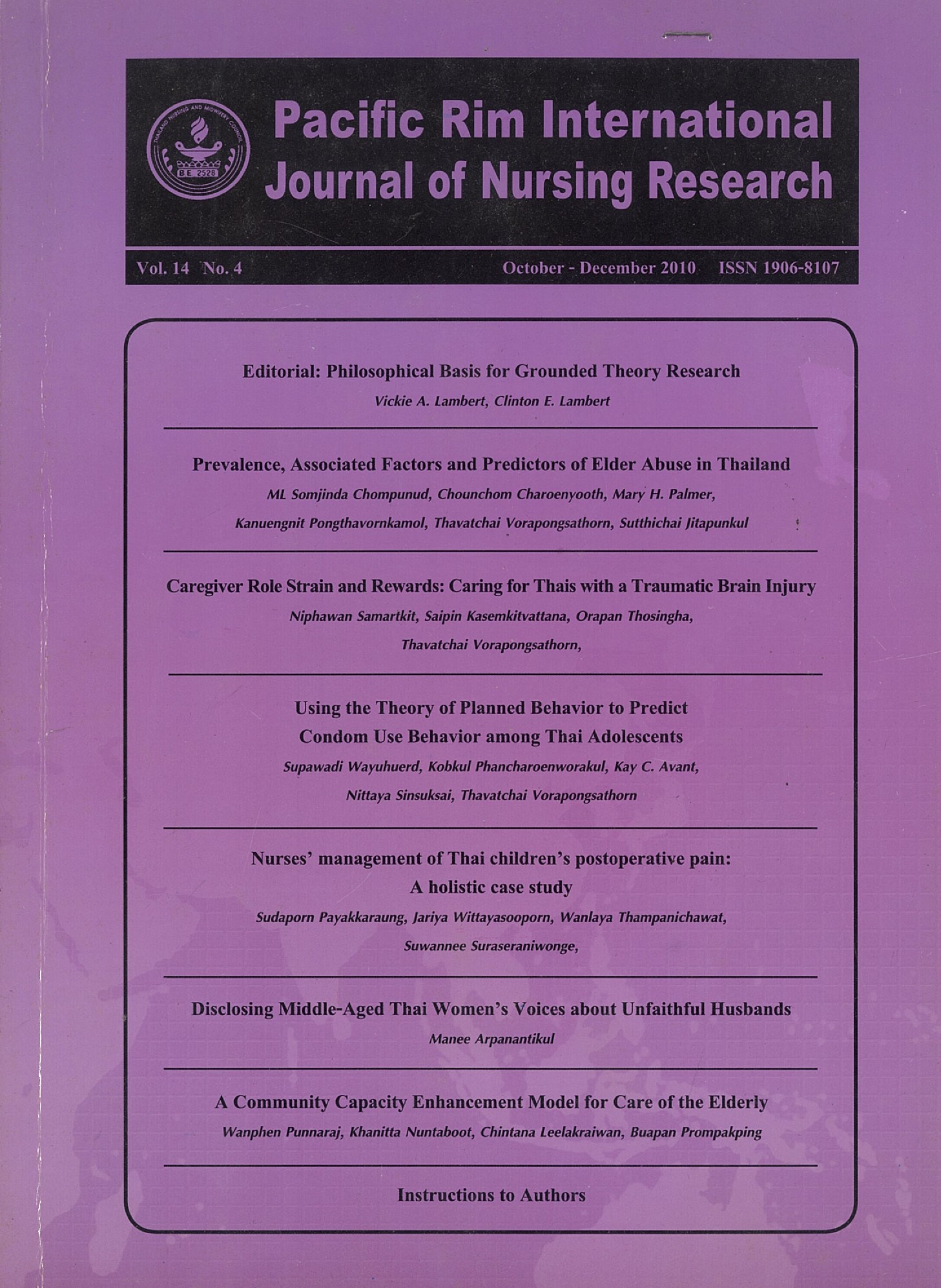Nurses’ Management of Thai Children’s Postoperative Pain: A Holistic Case study
Keywords:
การจัดการของพยาบาลต่อความเจ็บปวด, ความเจ็บปวดของเด็กหลังผ่าตัด, ประเทศไทย, Nurses’ pain management, Children’s postoperative pain, ThailandAbstract
บทคัดย่อ
พยาบาลมีบทบาทที่สำคัญในการจัดการความเจ็บปวดหลังผ่าตัดของผู้ป่วยเด็ก เนื่องจากพยาบาลเป็นผู้ดูแลผู้ป่วยเด็กตลอด 24 ชั่วโมง จึงมีโอกาสในการประเมินและบรรเทาความเจ็บปวดของผู้ป่วยเด็ก อย่างไรก็ตาม ยังมีความรู้และความเข้าใจที่จำกัดว่าพยาบาลจัดการต่อความเจ็บปวดหลังผ่าตัดในผู้ป่วยเด็กอย่างองค์รวมอย่างไรและทำไมจึงปฏิบัติเช่นนั้น รวมทั้งปฏิสัมพันธ์ระหว่างพยาบาลกับแพทย์หรือผู้ดูแลเป็นอย่างไร การศึกษานี้จึงมีวัตถุประสงค์เพื่อบรรยายการจัดการของพยาบาลต่อความเจ็บปวดหลังผ่าตัดของผู้ป่วยเด็กในสถานการณ์ที่เกิดขึ้นจริงในบริบทของหอผู้ป่วยไอซียูศัลยกรรมเด็กและหอผู้ป่วยศัลยกรรมเด็ก
การวิจัยกรณีศึกษาเชิงบรรยายนี้ ได้ใช้รูปแบบการศึกษาแบบองค์รวมพหุกรณีศึกษาโดยมุ่งเน้นการจัดการของพยาบาลที่เป็นกรณีศึกษาต่อความเจ็บปวดหลังผ่าตัดในเด็กไทย ข้อมูลรวบรวมได้จากแหล่งต่างๆประกอบด้วย 1) การสังเกตกิจกรรมของพยาบาลในการจัดการต่อความเจ็บปวด และปฏิสัมพันธ์ของพยาบาลกับแพทย์ ผู้ป่วยเด็ก และผู้ดูแล 2) การทบทวนแฟ้มประวัติของผู้ป่วยเด็ก เช่น เอกสารที่เกี่ยวข้องกับนโยบายการจัดการความเจ็บปวด แผนการรักษาของแพทย์และบันทึกของพยาบาลเกี่ยวกับการจัดการความเจ็บปวดโดยใช้ยาแก้ปวดและไม่ใช้ยาแก้ปวด และ 3) การสัมภาษณ์พยาบาล แพทย์ และผู้ดูแล
ผลการศึกษาพบว่าพยาบาลได้ใช้วิธีในการจัดการความเจ็บปวดของผู้ป่วยเด็ก 3 วิธีการ คือ 1) การบริหารยาแก้ปวด 2) การดูแลทางเลือกหรือการบรรเทาความเจ็บปวดโดยไม่ใช้ยาแก้ปวด และ 3) การมีส่วนร่วมของผู้ดูแล รูปแบบจำลองของการจัดการความเจ็บปวดแสดงให้เห็นปฏิสัมพันธ์ของพยาบาล แพทย์ และผู้ดูแล ซึ่งมีผลต่อการตัดสินใจของพยาบาลในการจัดการความเจ็บปวดของเด็ก นอกจากนี้ยังมีการอธิบายแบบแผนของพยาบาลในการจัดการความเจ็บปวดของเด็ก ผลการศึกษานี้เน้นให้เห็นว่าแนวปฏิบัติการพยาบาลทางคลินิกและโปรแกรมฝึกอบรมการจัดการความเจ็บปวดในเด็กควรได้รับการพัฒนาต่อไป
คำสำคัญ: การจัดการของพยาบาลต่อความเจ็บปวด; ความเจ็บปวดของเด็กหลังผ่าตัด; ประเทศไทย
Abstract
Nurses, due to caring for children 24 hours a day, play a vital role in the managementof children’s’ postoperative pain. However, little is known, holistically, about how nurses managechildren’s postoperative pain, including interactions among fellow nurses, other healthcareprofessionals and caregivers. Thus, this study aimed to describe how nurses manage children’spostoperative pain in the real-life context of a pediatric surgical intensive care unit and a pediatricsurgical unit.
A descriptive case study was conducted using a multiple-case (holistic) design. The casestudy focused on how selected nurses managed Thai children’s postoperative pain. Data werecollected from multiple sources, including: 1) observations of nurses’ pain management activitiesand interactions with physicians, children and family caregivers; 2) review of children’s medicalrecords, i.e. documents related to pain management policies, physicians’ prescriptions, and nurses’pharmacological and non-pharmacological interventions; and, 3) interviews with nurses, physiciansand family caregivers.
Three nursing strategies used to manage children’s postoperative pain found were: 1)analgesic administration; 2) providing alternative care or non-pharmacological interventions; and,3) family caregiver involvement. The nurses’ pain management model revealed nurses hadinteractions with physicians and caregivers that impacted the nurses’ decisions regardingmanagement of the children’s postoperative pain. In addition, the nurses’ patterns used inmanagement of children’s postoperative pain were identified and described. The findings imply theneed for clinical practice guidelines, as well as an educational program for children’s postoperativepain management.
Key words: Nurses’ pain management; Children’s postoperative pain; Thailand
Downloads
How to Cite
Issue
Section
License
Copyright: The Pacific Rim International Journal of Nursing Research, Thailand Nursing & Midwifery Council has exclusive rights to publish, reproduce and distribute the manuscript and all contents therein.







.png)


